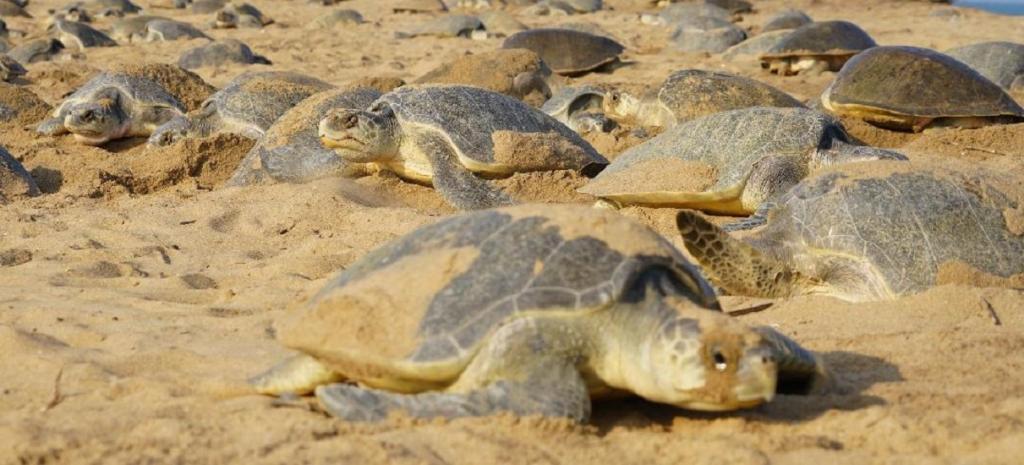OdishaWeather and Environment
Mass Nesting Of Endangered Olive Ridley Begins At Gahirmatha Marine Sanctuary

Kendrapara, Mar 26 : The mass nesting of Olive Ridley sea turtles has commenced at Gahirmatha Marine Sanctuary since Friday, DFO of Rajnagar Mangrove forest and wildlife Division Jangiya Datta Pati said on Saturday. Pati said a record number of over 2.45 lakh of female endangered Olive Ridley sea turtles have laid eggs at the nesting beach of Nasi-II within a span of 24 hours. The mass nesting phenomenon, he said, would continue for nearly four to five days. This is the first time in the history of Gahirmatha Marine Sanctuary where such a large number of endangered Olive Ridley sea turtles came for laying eggs on the first day of of Mass nesting ,the DFO said.
The forest personnel have taken all the precautionary measures to provide a congenial atmosphere for the Olive Ridley sea turtles for ongoing mass nesting at the golden beach of Nasi II, the largest rookery of the species ,Pati said. He said “We are yet to spot the tagged turtle that came to lay eggs on the first day as on the first and second day generally young female turtles used to come for laying eggs en mass. The DFO hoped that the tagged turtle would come on third or fourth day of the mass nesting phenomenon During the day hour , the turtles remain in coast due to heat whereas during the evening hours turtles appear en mass for laying eggs.
The female turtles tend to move towards the beaches in large synchronized concentrations and lay 100- 120 eggs in one go. The Olive Ridleys lay eggs at midnight in 45 centimeters pits, which they dig with their rear flippers. After laying the eggs in the pits, the female turtles cover the nests with sand and return to the deep sea in a zigzag manner to confuse predators about the location of the nests The hatchlings emerge from these eggs after 45-55 days and find their way to the sea creating a cacophony. It is one of Nature’s rare phenomena where babies grow without their mother,the DFO said. Turtle nests have been counted through segment wise at Nasi –II beach . As many as 28 segments have been formed at Nasi-2 beach. Each segment has been formed with 100 meter width . About 70 forest personnel were deployed to count the turtle nest in each segment in an hour , official sources said. The Defence Research and Development Organisation (DRDO) at Wheeler island, located close to Nasi II beach, has masked the light to provide security to the endangered species for laying eggs. Forest officials said the sea turtle normally skips from the shore for laying eggs when they come in contact with lights. The endangered Olive Ridley sea turtle,protected under Schedule 1 of wildlife Protection Act,1972 and accorded highest protection like endangered tigers, grows up to 75 centimeters (25 inches) in length . The forest personnel have erected a 3 kms long fencing to restrict the entry of canines into the Nasi II. This apart steps have been taken to guard the nesting grounds to protect the turtle eggs from predators like crow and eagle ,the DFO said. The movement of Olive Ridleys normally found in the deep sea of Bay of Bengal in between October last week and November first week, even the mating pair generally found in mid November at the deep sea. During the breeding season, males and females migrate from their feeding ground to the breeding ground, mating occurs in the offshore waters. The endangered Olive Ridleys rarely turn up in such large numbers anywhere in the planet other than the golden beaches of Gahirmatha marine sanctuary for laying eggs.Pati said Notably, about 3.49 lakh of endangered Olive Ridley sea turtles came to the golden beaches of Gahirmatha Marine sanctuary, to lay eggs within a span of two weeks from March 10 to March 24 in 2021.
with agency inputs





